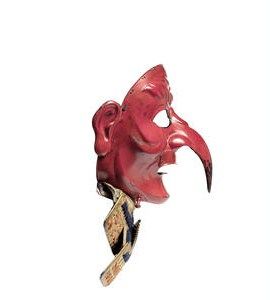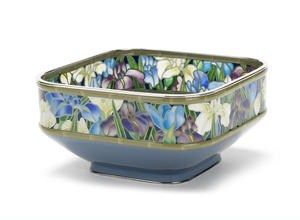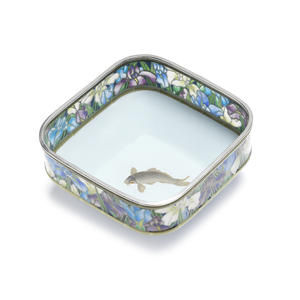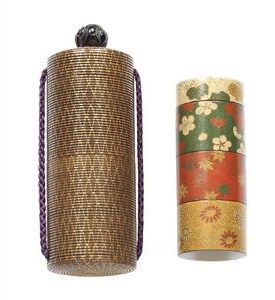Fearsome mask sells for exceptional price in Bonhams Fine Japanese Art Sale
Estimated at £3,500 – 4,000, bidders fiercely competed for the coveted mask, which eventually sold for £121,250. Photo: Bonhams
LONDON.- A striking red mask (tengu somen) forged out of a single piece of iron was one of the top lots in the Fine Japanese Art sale that took place on the 17th May at Bonhams, New Bond Street.
Estimated at £3,500 – 4,000, bidders fiercely competed for the coveted mask, which eventually sold for £121,250. The mask was in the form of tengu, a bird-like spirit who is often depicted with a reddish face and crow-like beak. In Japanese folklore the tengu is a protective, yet mischievous spirit and a popular mask subject. A mask such as this would have originally been used as a piece of armour in the 13th century, but later examples were made as showpieces for high ranking lords.
A tengu somen (mask). By Geishu Myochin Kiyoyoshi, mid Edo Period, 18th/19th century. Photo: Bonhams
The iron mask forged in one piece with the beak and ears riveted on, beneath the chin are two otayori no kugi, lacquered red overall with black on the point of the beak, the interior of the mask gold-lacquered; a two-lame yodarekakeof kiritsuke kozane; gold-lacquered and laced in dark blue; the kebiki odoshi is attached to the mask by a leather strip.33cm (13in). Sold for £121,250
朱塗総面 天狗 藝州明珍清吉作 江戸時代中期(18/19世紀)
The tengu, a bird-like spirit, is often depicted with a reddish face and a crow-like beak. In Japanese folklore the tengu is a protective, yet mischievous spirit and a popular mask subject.
The existence of somen (full mask) goes back to the Muromachi Period but quickly declined in popularity as the full-coverage of the face was found to be uncomfortable and impractical since it did not provide any functional advantage. They continued to be made as showpieces for high-ranking lords as opposed to practical armour accoutrements.
The top lot of the sale was an intricate cloisonné enamel and partial plique-à- jour square bowl by Ando Jubei from the Meiji Period (1868-1912). The bowl had an extraordinary interplay of colours, with a subtle use of traditional design and received much interest from international buyers. Estimated at £15,000 – 20,000, the bowl realised £145,250.
A fine cloisonné enamel and partial plique-à-jour square bowl. By Ando Jubei, Meiji Period. Photo: Bonhams
The interior decorated with a single carp worked in gold wire, swimming at the centre on a pale blue ground, the entire rim delicately worked in silver wire and totai-jippo with a band of bearded purple, blue and white irises, between jade-green borders simulating bamboo, above a contrasting aoi-fuji ground; applied with silver mounts, the base signed with the silver wire seal of Ando Jubei and stamped jungin (real silver); with separate, en-suite wood stand and original, cushioned wood storage box. 9.5cm x 19.1cm x 19.1cm (3¾in x 7½in x 7½in), the wood stand 7.5cm x 13.6cm (3in x 5 3/8in). (3). Sold for £145,250
菖蒲に鯉図七宝鉢 附 木製透台 安藤重兵衛作 明治時代
The bowl is extraordinary for the interplay of its colours and its subtle uses of traditional design; the rim decorated with a band of irises made in partial plique-à-jour (totai), in shades of green and hues of violet and blue, sets off perfectly the blue depth of the bowl's interior and the exterior.
Compare with a remarkably similar bowl, decorated with two bees in the centre bordered by a band of plique-à-jour grapes, leaves and fruits in shades of green and purple and blue hues, executed in the same exceedingly difficult technique, made by Gonda Hirosuke for the Ando Company, illustrated by Lawrence A. Coben and Dorothy C. Ferster,Japanese Cloisonné: History, Technique, and Appreciation, 1982, p.104, colour plate no.126.
Ando Jubei is traditionally said to have brought back to Japan, from the World Fair in Paris 1900, a piece of plique-à-jour enamel by Fernand Thesmar (1843-1912) from which Kawade Shibataro is said to have been able to discover the methods of manufacture. However, the recent discovery of a vase by Namikawa Sosuke, made in the same technique, in the Walters Art Gallery, Baltimore, and exhibited in Chicago in 1893, has cast considerable doubt on this belief.
Plique-à-jour is made by the removal of the metal body after firing so that the enamel and the wires support themselves. The breakage rate was very high and consequently many pieces were originally sold with small cracks. This extant example in perfect condition is therefore a superb testimony to the perfectionism of its maker.
Further highlights included a 17th century six-panel folding screen, depicting the Uji River. Reflecting the renowned beauty of the river and its surroundings, the screen sold for £115,250.
Anonymous. Edo Period, 17th century. A six-panel folding screen. Photo: Bonhams
painted in ink, colour, gold and silver on gilded paper, decorated with willow trees by a broad, arching bridge, with a waterwheel turning in the water beside stone-filled baskets; with extensive details enhanced in moriage, unsigned. 176.5cm x 368cm (69½in x 145in). Sold for £115,250
柳橋水車図屏風 無銘 六曲一隻 紙本金地着色 江戸時代(17世紀) Originally the left screen of a pair, the image depicted is generally considered to represent the bridge spanning the Uji River. The willow trees placed either side of the bridge allude to the progression of seasons, three willows with small, delicate leaves at the right and centre hint at Spring, whilst the fuller, longer leaves at the left suggest Summer.
Originally the left screen of a pair, the image depicted is generally considered to represent the bridge spanning the Uji River. The willow trees placed either side of the bridge allude to the progression of seasons, three willows with small, delicate leaves at the right and centre hint at Spring, whilst the fuller, longer leaves at the left suggest Summer.
The bold, geometrically-conceived bridge is softened both by the round forms of a large waterwheel that turns in the stream and the three-stone-filled baskets (jakago) that protect the embankments. Further movement is provided by the tiny crests of waves stirred up by the turning wheel whilst the extensive use of small squares of pieces of gold (reminiscent of Japanese lacquer decoration) are pasted onto larger areas of gold foil that form the irregular-formed clouds - applied abundantly to allow light to create subtle changes of reflection. Furthermore, the design of the asymmetrical composition is made in such a way, so that dependent of how much of the screen is opened, each segment would capture the light differently, creating an overall powerful effect of a majestic golden glow to the room.
The Uji River was known in ancient times for its good fishing, and its surroundings were valued for their outstanding beauty. The rolling hills, clear water, and magnificent bridge were celebrated in the anthologies of court poetry such as the Manyoshu (Collection of Ten Thousand Leaves; eighth century) and the Kokinshu(Collection of Poems from the Ancient and Modern Times; early tenth century). Such screen paintings clearly belonged to the Yamato-e genre, as they depicted both a seasonal progression and the beauty of a famous scenic location (meisho-e).
Uji was chosen as the site of several Autumnal episodes in the final chapters of the famous eleventh-century novel The Tale of Genji. In illustrated versions of this romantic tale, pictures for the Uji episodes invariably include the famous, broad bridge, willow trees, baskets and/or the waterwheel. About half a century later, the imagery associated with Uji took on religious connotations and it became home to the Pure Land (Jodo) Buddhist temple Byodoin and its famous Hoodo (Phoenix Hall). The temple and its grounds were a replica of Amida Buddha's Western Paradise, a three-dimensional construction based on the Kanmuryojukyo(Contemplation Sutra). Such literal manifestations of imaginary locations helped the aristocracy to envision Paradise, a place where they clearly hoped to return to after death; hence the reason why Uji was favoured by members of the Imperial Court who used the area as a retreat. Historic documents show a screen painting of Uji bridge in Autumn, which was displayed in the Imperial Palace in the ninth century. Perhaps the bridge was the metaphorical connection between this land and the Pure Land.
The Uji theme in painting therefore underwent several stages of transfomation before finally evolving into the magnificent decorative composition that is evident in the image presented here. With its contrasts of large dramatic and pictorial forms, brilliant metallic shimmer and shades of gold, this screen represents the height of Momoyama/Edo decorative style. The image has lost all former lofty associations with an actual place and has become, instead, a striking, bold, yet simple design that is just as attractive today as it was then.
At least eight more versions of this theme are known in American collections, and many others can be found in Japan. Most of these are virtually identical, except for minor variations in detail and quality. Compare with similar screens in The Art Institute of Chicago, The Mary Griggs Burke Collection at the Metropolitan Museum, The Nelson-Atkins Museum of Art, The Honolulu Academy of Arts, The Worcester Museum, Massachusetts, The Idemitsu Museum of Arts, and The Tokyo National Museum.
Works by Shibata Zeshin, one of the most famous masters of the Meiji Period currently making world record prices at auction, were also included in the sale. Having set a world record for the artist two days previously, Bonhams was delighted to present a range of works by Zeshin including a lacquer three-case inro (traditional Japanese medicine cases consisting of nested boxes)that sold for £79,250. A pair of lacquer paintings sold for £51,650, exceeding the presale estimate of £15,000 – 20,000, and a lacquer four-case inro sold for £49,250.
A lacquer three-case saya inro. By Shibata Zeshin (1807-1891), Meiji Period. Photo: Bonhams
 The sheath of cylindrical form, decorated with an all-over design resembling netting in gold hiramakie, enclosing within a similarly-shaped, cylindrical three-case inro, each case lacquered on the exterior in coloured hiramakie with a band of different blossoms (chrysanthemums, white and red plum, maple leaves and paulownia) representing the four seasons, the bottom signed in gold lacquer Zeshin, with carved black-lacquered ojime, unsigned. 7.5cm (2 15/16in). (2). Sold for £79,250 inc
The sheath of cylindrical form, decorated with an all-over design resembling netting in gold hiramakie, enclosing within a similarly-shaped, cylindrical three-case inro, each case lacquered on the exterior in coloured hiramakie with a band of different blossoms (chrysanthemums, white and red plum, maple leaves and paulownia) representing the four seasons, the bottom signed in gold lacquer Zeshin, with carved black-lacquered ojime, unsigned. 7.5cm (2 15/16in). (2). Sold for £79,250 inc
Provenance: Maurice Champoud collection.

/https%3A%2F%2Fprofilepics.canalblog.com%2Fprofilepics%2F1%2F0%2F100183.jpg)
/https%3A%2F%2Fstorage.canalblog.com%2F03%2F02%2F119589%2F96711876_o.jpg)
/https%3A%2F%2Fstorage.canalblog.com%2F11%2F31%2F119589%2F94773502_o.jpg)
/https%3A%2F%2Fstorage.canalblog.com%2F20%2F83%2F119589%2F94772815_o.jpg)
/https%3A%2F%2Fstorage.canalblog.com%2F26%2F72%2F119589%2F75604929_o.jpg)
/https%3A%2F%2Fstorage.canalblog.com%2F59%2F60%2F119589%2F26458628_o.jpg)











/http%3A%2F%2Fstorage.canalblog.com%2F45%2F84%2F119589%2F128381154_o.jpg)
/http%3A%2F%2Fstorage.canalblog.com%2F09%2F25%2F119589%2F128370615_o.jpg)
/http%3A%2F%2Fstorage.canalblog.com%2F05%2F95%2F119589%2F126875799_o.jpg)
/http%3A%2F%2Fstorage.canalblog.com%2F44%2F72%2F119589%2F122505070_o.jpg)